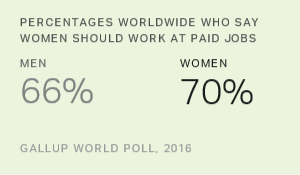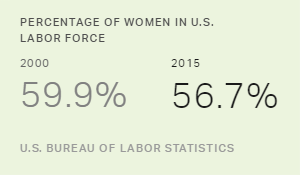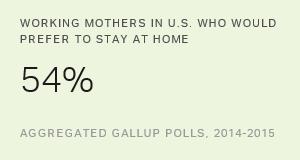Story Highlights
- 70% of all women, 66% of men would prefer that women have paid jobs
- 58% of women not in the workforce would like to work at paid jobs
- 41% of women would like to be able to work and care for their families
WASHINGTON, D.C. -- Although women make up half of the world's population, barely half of them today are participating in the workforce. A new report released Wednesday by Gallup and the International Labour Organization shows this is not what most of the world's women -- or men -- want. Seventy percent of women worldwide, and a similar 66% of men, say they would prefer women to work at paid jobs (combining those who prefer women only work at paid jobs and those who prefer they work at paid jobs and care for their homes and families). These figures are more than double the percentages of those who would prefer that women just stay home.
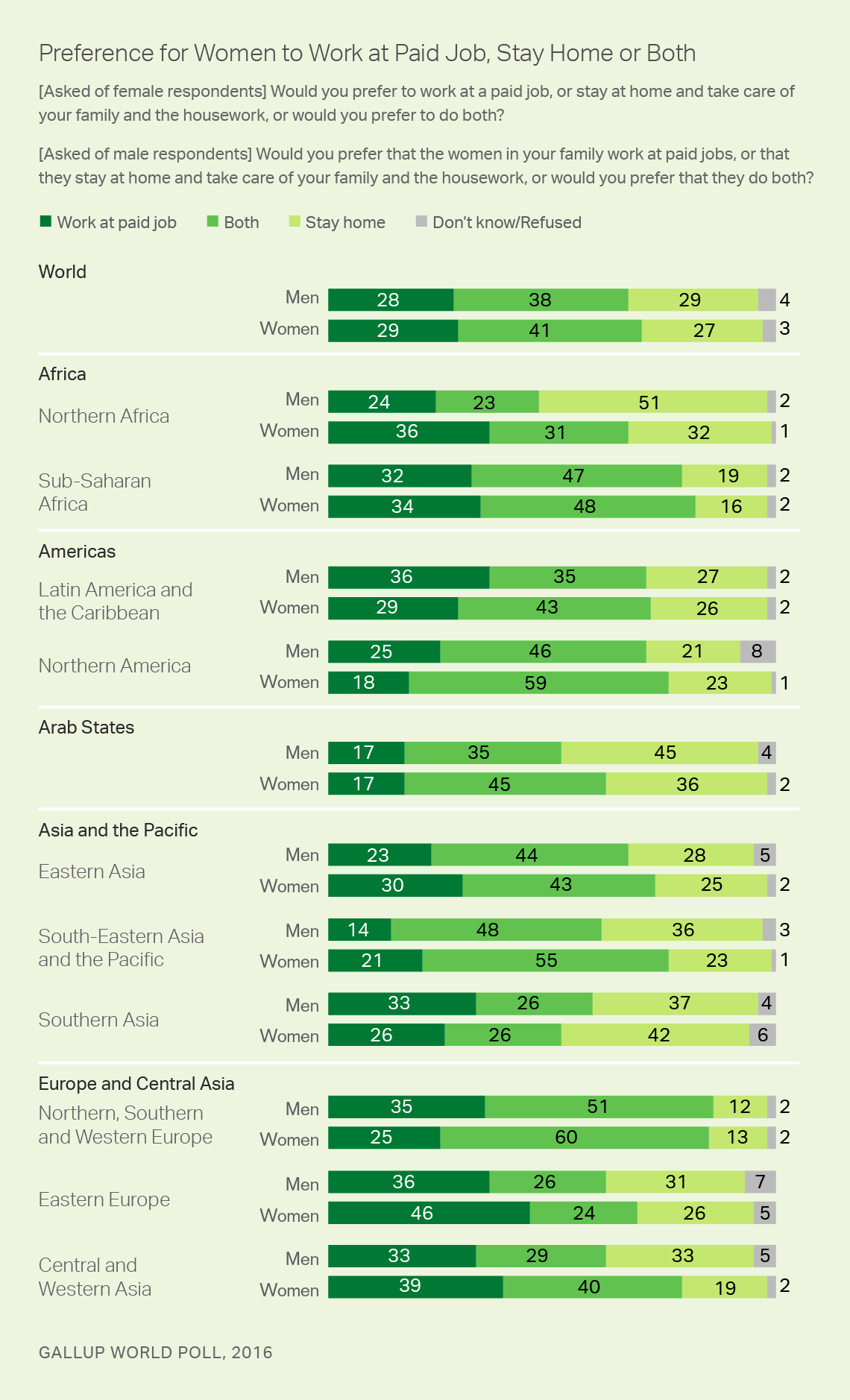
These results are just a few of the insights on the world of work from the ILO-Gallup report, "Towards a better future for women and work: Voices of women and men." The report represents a collaboration between the ILO and Gallup to provide the first-ever account of how men and women worldwide think and feel about women and work. In 2016, in support of the ILO's Women at Work Centenary Initiative, Gallup asked nearly 149,000 women and men in 142 countries and territories about their attitudes toward women and the world of work. The questions covered a range of topics, from women's and men's preferences for women in the labor market to the top challenges that working women face in their countries and territories.
While the report shows gender equality is still far from being achieved, it also indicates men and women are not always as far apart in their attitudes as people might assume. About three in 10 women worldwide would prefer to work at paid jobs (29%), and a similar percentage would prefer to stay home (27%). Four in 10 women would prefer to do both (41%). Men want the same for the women in their families: 28% would like these women to have paid jobs, 29% would like them to stay home and 38% would prefer they do both.
In places such as Northern, Southern and Western Europe -- where men and women are most likely to favor women working at paid jobs -- there is no gender gap on the issue. Nearly nine in 10 women and men in this region say that women should only work at paid jobs or work at paid jobs and care for their families and homes. Gaps are also almost nonexistent or extremely narrow in other regions such as sub-Saharan Africa, Latin America and the Caribbean, Northern America, and Eastern Asia.
At the same time, the results reveal some real gender divides in several regions that may reflect pressures in cultures where men are traditionally perceived as the chief providers and where women's workforce participation tends to be low. For example, a slim majority of men in Northern Africa (51%) -- the highest percentage worldwide -- and nearly half of men in the Arab States (45%) would prefer that women stay home. This is at odds with how women in these regions feel: 32% of women in Northern Africa and 36% of women in Arab States say that women should just stay at home.
A Majority of Women Out of the Workforce Would Like to Be Working
The results in Northern Africa and the Arab States, where women's labor force participation rates are barely above 20%, demonstrate that women's lack of workforce participation doesn't mean that they want to stay at home. In fact, the majority of women worldwide (58%) who are out of the workforce (meaning they were not employed within the past seven days, are not looking for work and/or are not available to start work) say they would like either to work at paid jobs (22%) or to work and care for their homes and families (36%).
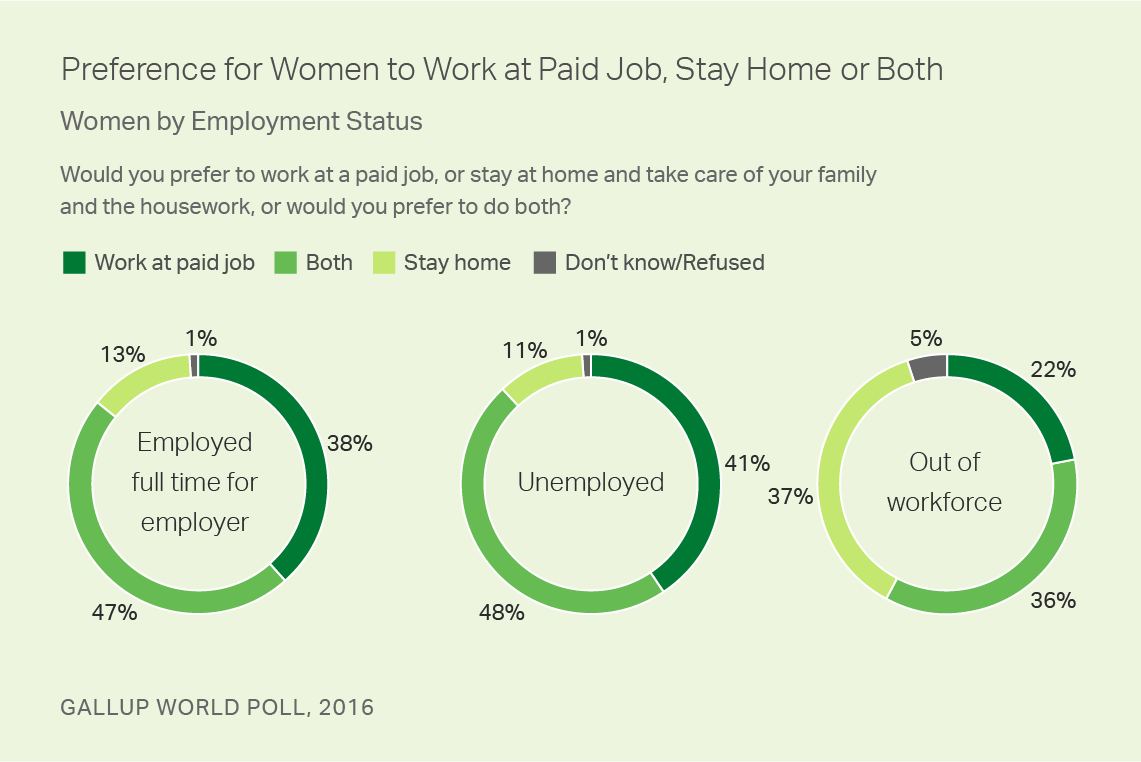
More importantly, this is true in almost all regions worldwide. This includes several regions such as the Arab States, where women's labor participation rates are low, and regions where labor participation rates are higher, such as in Northern, Southern and Western Europe.
Among women who are in the workforce, unemployed women, not surprisingly, are the most likely to say they would prefer to only work at paid jobs (41%), but nearly as many women who are working full time for an employer (38%) say the same. However, women in both groups are most likely to want to both have paid jobs and care for their families and homes.
Bottom Line
The findings in the latest ILO-Gallup report illustrate the constraints that still exist between women and men in many parts of the world. Women face unique challenges in every region, country, territory and demographic group -- but in many places, men share their views on women and work. Leveraging this common ground will be crucial in meeting the United Nations' Sustainable Development Goal 8 of achieving productive employment and decent work for all women and men by 2030.
To read the full report and see results for all 142 countries and territories on this and other questions asked in the survey, download the report.
Survey Methods
Results are based on telephone and face-to-face interviews with approximately 1,000 adults in 142 countries and territories, aged 15 and older, conducted in 2016. The total sample size is 148,724. Global and regional aggregates were calculated by projection weighting according to population size, and figures are representative of the entire adult population per region.
For results based on the sample of men and women who answered this question, at the sub-region level the margin of sampling error ranged from ±1.2 percentage points to ±4.8 percentage points at the 95% confidence level. The margin of error reflects the influence of the study's design and data weighting. In addition to sampling error, question wording and practical difficulties in conducting surveys can introduce error or bias into the findings of public opinion polls.
For more complete methodology and specific survey dates, please review Gallup's Country Data Set details.
Learn more about how the Gallup World Poll works.
